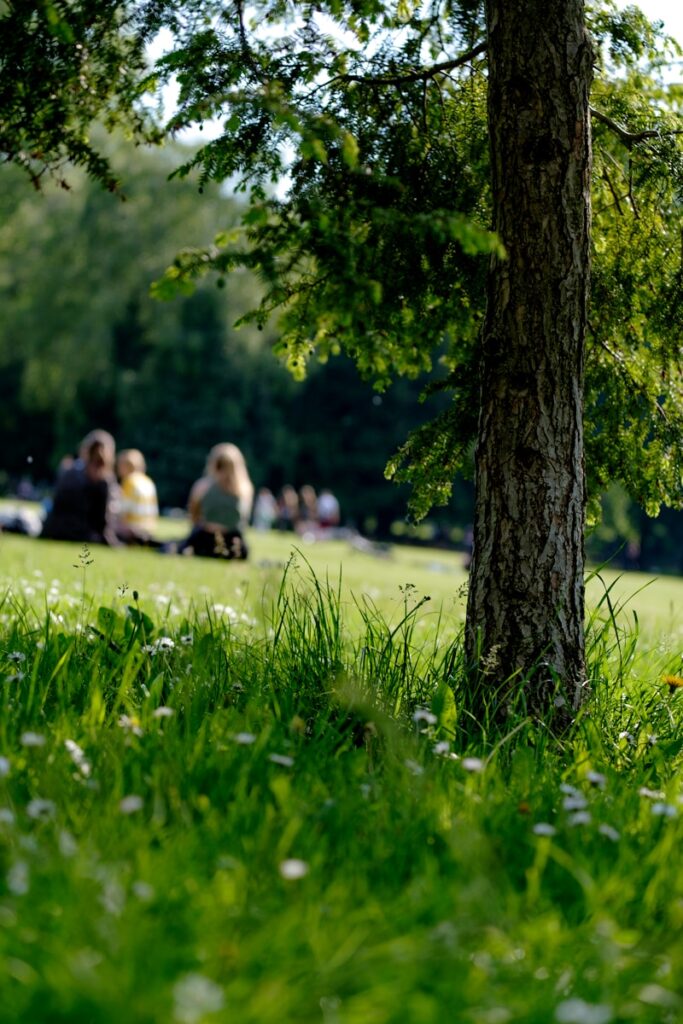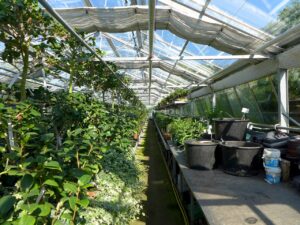Blog
The Benefits of Green Retirement Communities
Discover the environmental benefits of green retirement communities. From energy-efficient buildings to sustainable transportation, these communities are promoting a healthier planet and a happier lifestyle. Learn how going green in retirement can make a world of difference.
Imagine living in a community that not only offers a serene and tranquil retirement experience but also contributes to a healthier planet. That’s exactly what green retirement communities have to offer. These unique living spaces are dedicated to sustainability and environmental consciousness, bringing together the best of retirement living with the benefits of preserving our environment. From energy-efficient homes to extensive recycling programs, green retirement communities not only help protect the planet but also promote a healthier and happier lifestyle for their residents. In this article, we will explore the numerous environmental benefits that these communities bring, along with the positive impact they have on businesses and individual health. So get ready to discover how going green in retirement can make a world of difference.
Reduced Carbon Footprint
Energy-efficient buildings
Green retirement communities focus on constructing energy-efficient buildings to reduce their carbon footprint. By using energy-efficient materials, insulation, and appliances, these communities significantly minimize their overall energy consumption. Additionally, the integration of smart technologies and energy management systems allows for better control and optimization of energy usage in retirement homes. With reduced energy consumption, these communities contribute to the reduction of greenhouse gas emissions and help combat climate change.
Renewable energy sources
In line with their commitment to sustainability, green retirement communities often utilize renewable energy sources to power their facilities. Solar panels are commonly installed on rooftops to harness the abundant energy from the sun. Additionally, wind turbines may be employed to generate clean electricity, taking advantage of the surrounding natural resources. By embracing renewable energy, these communities drastically reduce their dependence on fossil fuels, promoting a more sustainable and eco-friendly way of living.
Sustainable transportation options
Green retirement communities emphasize sustainable transportation options to reduce the environmental impact caused by commuting and transportation-related activities. They often provide residents with electric vehicle charging stations, encouraging the use of electric cars, which produce significantly fewer emissions compared to traditional vehicles. Moreover, these communities offer well-planned pedestrian and cycling infrastructure, allowing residents to easily walk or bike around the community, minimizing the need for cars. By promoting sustainable transportation alternatives, these communities contribute to the reduction of air pollution and traffic congestion.
Conservation of Natural Resources
Water conservation
Green retirement communities prioritize water conservation through various measures. They implement water-efficient fixtures and appliances, such as low-flow faucets and toilets, to minimize water wastage. Additionally, these communities often invest in rainwater harvesting systems, allowing them to collect and store rainwater for non-potable purposes like irrigation and landscaping. By reducing water consumption and maximizing the use of natural water sources, green retirement communities play a vital role in conserving this precious resource.
Waste reduction and recycling
To minimize waste and promote recycling, green retirement communities implement comprehensive waste reduction and recycling programs. These communities provide residents with designated recycling bins, making it easy for them to separate recyclable materials from general waste. Moreover, they often collaborate with local recycling facilities to ensure that recyclable materials are appropriately processed. By prioritizing waste reduction and recycling, these communities contribute to the conservation of natural resources and reduce the amount of waste sent to landfills.
Preservation of green spaces
Green retirement communities understand the importance of preserving and protecting green spaces. They prioritize the conservation of existing natural habitats, such as forests, wetlands, and meadows, by implementing strict land-use policies. These policies ensure that any development or construction respects the ecological integrity of the surrounding environment. Additionally, these communities often create and maintain green spaces within their premises, providing residents with areas for relaxation, recreation, and connection with nature. By valuing and preserving green spaces, green retirement communities promote biodiversity and enhance the overall ecological balance.

Improved Air Quality
Limited pollution from construction and maintenance
Green retirement communities prioritize environmentally friendly construction and maintenance practices to limit pollution. During construction, they employ sustainable construction techniques that minimize the release of harmful pollutants into the air. This includes using low-VOC (volatile organic compound) paints and adhesives, as well as adopting proper waste management practices. Furthermore, in the maintenance phase, these communities prioritize regular air quality monitoring and implement eco-friendly cleaning and maintenance protocols. By minimizing pollution from construction and maintenance activities, green retirement communities contribute to improved air quality for residents and the surrounding environment.
Implementation of green technologies
Green retirement communities leverage innovative green technologies to improve air quality within their premises. These technologies include advanced air filtration systems, which effectively remove pollutants and allergens from indoor air, ensuring a healthier living environment for residents. Additionally, these communities prioritize the use of energy-efficient ventilation and heating systems, further contributing to cleaner air by reducing energy consumption and limiting the release of pollutants. By adopting and implementing green technologies, green retirement communities actively promote and maintain high indoor air quality standards.
Use of eco-friendly materials
To enhance air quality and minimize environmental impact, green retirement communities prioritize the use of eco-friendly materials in construction and renovation projects. They opt for sustainable building materials that have a lower emissions profile and are free from harmful chemicals and toxins. These materials may include bamboo flooring, recycled or reclaimed wood, and non-toxic insulation. By choosing eco-friendly materials, these communities not only reduce the release of pollutants into the air but also contribute to the long-term health and well-being of residents.
Enhanced Biodiversity
Protection of natural habitats
Green retirement communities recognize the importance of protecting and preserving natural habitats to promote biodiversity. They implement strict guidelines and policies to ensure the conservation of existing ecosystems within their premises. These policies may include restrictions on clearing or altering natural habitats, such as woodlands or wetlands, and promoting the restoration of degraded areas. By safeguarding natural habitats, these communities provide shelter and support for a diverse range of plant and animal species, contributing to the overall biodiversity of the region.
Creation of wildlife-friendly spaces
As part of their commitment to enhancing biodiversity, green retirement communities actively create wildlife-friendly spaces within their premises. They incorporate features like bird feeders, butterfly gardens, and nesting boxes to attract and support various wildlife species. Moreover, they may establish designated wildlife corridors and green belts, creating safe passage and habitats for animals to thrive. The creation of wildlife-friendly spaces not only adds beauty and serenity to the community but also fosters a deeper connection between residents and the natural world.
Planting native species
Green retirement communities prioritize the planting of native species in their landscaping and gardening efforts. Native plants are adapted to the local climate and soil conditions, requiring less maintenance and watering. They also provide essential food and habitat for native insects, birds, and other wildlife, thereby supporting local ecosystems. By planting native species, green retirement communities contribute to the preservation of regional biodiversity and help restore ecosystems that human activities may have impacted.

Efficient Water Management
Rainwater harvesting
Green retirement communities embrace rainwater harvesting systems to efficiently manage and utilize water resources. These systems collect rainwater from rooftops and other surfaces, storing it for later use. The harvested rainwater can then be used for irrigation, flushing toilets, and other non-potable purposes. By implementing rainwater harvesting, these communities reduce their reliance on municipal water supplies and contribute to water conservation efforts.
Water-efficient landscaping
To further enhance water management, green retirement communities prioritize water-efficient landscaping practices. They utilize drought-tolerant plants and employ efficient irrigation methods, such as drip irrigation, to minimize water wastage. Additionally, they prioritize proper soil management techniques to improve water retention and reduce runoff. By adopting water-efficient landscaping, these communities not only conserve water but also create visually appealing and sustainable outdoor spaces for residents to enjoy.
Use of graywater for non-potable purposes
Green retirement communities maximize the use of graywater, which is wastewater generated from sources like sinks, showers, and washing machines, for non-potable purposes. Specialized treatment systems are often implemented to filter and treat graywater, making it suitable for irrigation and other non-drinking purposes. By utilizing graywater, these communities reduce the strain on freshwater resources and promote sustainable water management practices.
Community Food Production
Organic vegetable gardens
Green retirement communities often establish organic vegetable gardens to promote community food production. These gardens provide residents with the opportunity to grow their own fresh and organic produce, reducing the reliance on long-distance food transportation and promoting self-sufficiency. Moreover, these gardens foster a sense of community and connection among residents, creating shared spaces for learning, working together, and enjoying the harvest of their labor.
Greenhouses for year-round cultivation
To ensure year-round food production, green retirement communities may incorporate greenhouses within their premises. These greenhouses provide controlled environments, allowing for the cultivation of crops even during colder months or in regions with challenging climates. By utilizing greenhouses, these communities can extend their food production capabilities and continue to enjoy fresh, nutritious produce throughout the year.
Collaboration with local farmers
Green retirement communities often collaborate with local farmers to support and promote sustainable and local food systems. They may establish partnerships with nearby farms to source fresh produce, dairy products, and meats. By supporting local farmers and producers, these communities contribute to the local economy, reduce the carbon footprint associated with long-distance food transportation, and ensure residents have access to high-quality and sustainably produced food.

Healthy and Sustainable Materials
Non-toxic paints and finishes
To promote healthier living environments, green retirement communities prioritize the use of non-toxic paints and finishes in their buildings and residences. Traditional paints and finishes often contain volatile organic compounds (VOCs), which can contribute to poor indoor air quality and various health issues. By opting for low-VOC or VOC-free alternatives, these communities create safer and healthier living spaces for their residents.
Locally sourced materials
Green retirement communities aim to reduce their environmental impact by sourcing materials locally whenever possible. By avoiding long-distance transportation, they minimize carbon emissions associated with the transportation of building materials. Additionally, sourcing materials locally supports local businesses, promotes the local economy, and fosters a sense of community within the retirement community.
Recycled building materials
To minimize resource consumption and waste, green retirement communities actively incorporate recycled building materials into their construction and renovation projects. Materials such as recycled glass, reclaimed wood, and recycled metals can be used to create beautiful and durable structures. By utilizing recycled building materials, these communities divert materials from landfills and reduce the extraction of natural resources, contributing to a more sustainable and circular economy.
Promotion of Active Lifestyles
Accessible outdoor fitness areas
Green retirement communities prioritize the development of accessible outdoor fitness areas to promote active lifestyles among residents. These areas may include walking paths, exercise stations, and outdoor fitness equipment designed for seniors. By providing well-designed and inclusive spaces for physical activity, these communities encourage residents to stay active, improving their overall health and well-being.
Walking and biking trails
In line with their commitment to sustainable transportation options, green retirement communities often feature well-maintained walking and biking trails within their premises. These trails provide residents with safe and enjoyable spaces to walk, jog, or bike, promoting physical activity while also facilitating an eco-friendly mode of transportation within the community. By creating pedestrian-friendly environments and encouraging alternative modes of transportation, these communities prioritize the health and well-being of their residents and reduce reliance on cars.
Opportunities for gardening and farming
Green retirement communities often offer opportunities for residents to engage in gardening and farming activities. Community gardens or individual garden plots allow residents to cultivate their own plants, grow food, and connect with nature. These activities provide not only physical benefits through active engagement but also therapeutic and mental well-being advantages. By fostering a sense of connection to the earth and fostering a deeper appreciation for food production, these communities promote healthy and sustainable lifestyles.

Engaging Environmental Education
Workshops on sustainable practices
Green retirement communities organize workshops and educational programs to provide residents with valuable knowledge and skills on sustainable practices. These workshops may cover topics such as energy conservation, waste management, organic gardening, and water efficiency. By empowering residents with the right information, these communities encourage the adoption of sustainable behaviors and foster a culture of environmental stewardship.
Wildlife observation programs
To enhance residents’ connection with nature, green retirement communities often organize wildlife observation programs. These programs may include guided nature walks, bird-watching events, and educational sessions on local wildlife. By immersing residents in the beauty of the natural world and helping them understand the importance of biodiversity, these programs promote a deeper appreciation for the environment and encourage conservation efforts.
Lectures on climate change and conservation
Green retirement communities invite experts and guest speakers to deliver lectures and presentations on climate change, conservation, and other environmental topics. These lectures provide residents with up-to-date information and insights into global and local environmental issues. By fostering an understanding of the challenges faced by the planet, these communities inspire residents to take action and make sustainable choices in their daily lives.
Well-being Benefits for Residents
Connection to nature improves mental health
Green retirement communities recognize the positive impact of nature on mental health and well-being. By incorporating green spaces, gardens, and natural landscapes into their design, these communities provide residents with access to the calming and rejuvenating effects of nature. Spending time outdoors, surrounded by greenery and fresh air, can reduce stress, improve moods, and enhance overall mental well-being.
Access to outdoor recreational activities
Green retirement communities offer a wide range of outdoor recreational activities tailored to the needs and interests of residents. These may include activities such as nature walks, yoga classes in natural settings, and organized sports. By providing opportunities for active engagement and connection with the natural environment, these communities promote physical health and overall well-being.
Healthier living environments
Through their commitment to sustainable practices and the use of eco-friendly materials, green retirement communities create healthier living environments for their residents. Improved indoor air quality, reduced exposure to harmful chemicals, and access to nature all contribute to better overall health and well-being. Living in a sustainable and environmentally conscious community allows residents to enjoy the many benefits of a healthy and balanced lifestyle.
In conclusion, green retirement communities make significant contributions to environmental preservation and sustainability. By implementing energy-efficient buildings, utilizing renewable energy sources, and promoting sustainable transportation options, these communities actively reduce their carbon footprint. Through the conservation of natural resources, improved air quality, enhanced biodiversity, and efficient water management, they prioritize the preservation of the environment. Furthermore, they engage in community food production, use healthy and sustainable materials, promote active lifestyles, and provide engaging environmental education, all leading to improved well-being for residents. Through their commitment to environmental and social responsibility, green retirement communities demonstrate that sustainable living is not only beneficial for the planet but also for individuals and communities alike.




